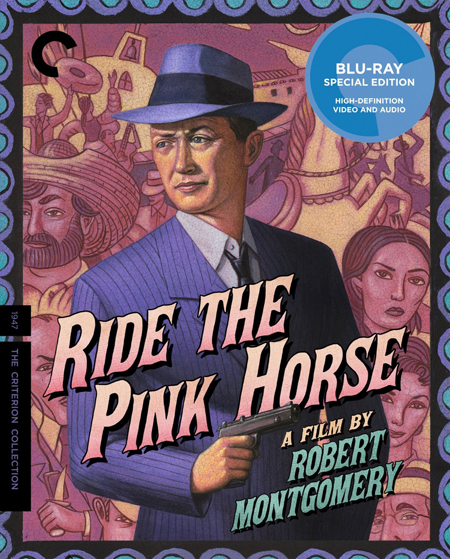
“BORDER TOWN NOIRâ€
By Raymond Benson
Most
film noir pictures take place in
urban centers—New York City, Los Angeles—where the big city is as much a
character as the unhappy humans in these often bleak and brutal, sometimes
brilliant, Hollywood crime films that spanned the early forties to the late
fifties. Film noir peaked in the latter half of the forties, with an
abundance of the classic titles released between 1946-1948.
One
of the more unique things about Ride the
Pink Horse is that the urban setting is gone. Instead, the action is set in
a border town in New Mexico, where there is indeed danger, to be sure, but
there’s also a little less pessimism among the inhabitants—unlike in the urban noirs in which everyone’s a cynic.
Interestingly, one might say that the “border town noir†could be a sub-set of
the broader category, for Ride the Pink
Horse isn’t the only crime movie of the period set away from the big city.
Orson Welles’ Touch of Evil is
another good example.
Ride the Pink Horse, based on a novel
by Dorothy B. Hughes, became actor Robert Montgomery’s second noir in which he both starred and
directed. His first directorial effort was Lady in the Lake (also 1947),
in which the actor played detective Phillip Marlowe. Here, Montgomery plays
Gagin, an ex-GI, with a take-no-guff attitude but also with a subtle sense of
cluelessness—he is definitely a fish out of water in “San Pablo.†His mission
there is to locate a crook named Hugo (Fred Clark) to avenge the murder of
Gagin’s best friend. What he thought might be a simple task turns out to be a
lot more complicated, for the FBI is in town in the form of amiable Retz (Art
Smith), and the Feds want Hugo, too. On his first night in town, Gagin falls
in with Pancho (Thomas Gomez), a Mexican who runs a cheap merry-go-round for
the kids, and Pila (Wanda Hendrix), a young woman who speaks little, but seems
to know a heck of a lot about the goings-on in town. As it turns out, Gagin
isn’t really the tough guy he pretended to be at the beginning. He really is in over his head, and he needs the
help of his newfound Mexican friends to simply survive.
The
merry-go-round could be some kind of metaphor for the film’s message—possibly
that we can go round and round and still wind up where we started. On the other
hand, the ride might suggest that it is a source of innocence, something to
which our hero can’t return. Even if you ride the pink horse; you get the same
truth on a horse of any other color.
The
setting’s flavor is pleasingly captured in the stark black and white
cinematography by Russell Metty, especially during the “Fiesta†sequences. One
striking sequence takes place with the camera on the merry-go-round—as it goes
around we see two thugs giving Pancho a beating at the side of the ride; with
every revolution our glimpse of the violence is increasingly upsetting. The
production design by Bernard Herzbrun and Robert Boyle, is very impressive,
seeing that, ironically, the picture was filmed on the Universal lot in
Hollywood and not in New Mexico.
The
story, adapted by Ben Hecht and Charles Lederer, is engaging enough, although Ride the Pink Horse doesn’t seem to
reach the climax that is promised by the opening half-hour. Nevertheless, the
performances are very good, especially that of Gomez, who, with this picture,
became the first Hispanic actor to be nominated for an Oscar—Best Supporting
Actor (1947).
Criterion’s
new 2K digital restoration looks sharp and clean. An audio commentary by film noir historians Alain Silver and
James Ursini accompanies the film. The only two extras are a new interview about
the film with Imogen Sara Smith, author of In
Lonely Places: Film Noir Beyond the City; and a radio adaptation starring
Montgomery, Hendrix, and Gomez. The booklet contains an essay by filmmaker and
writer Michael Almereyda.
Ride the Pink Horse
is
for film noir enthusiasts looking to
get out of the city and travel somewhere a little different.
CLICK HERE TO ORDER FROM AMAZON